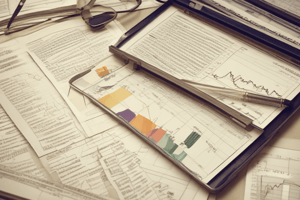Podcast
Questions and Answers
What is a major weakness of top-down analysis?
What is a major weakness of top-down analysis?
- It overlooks firm-specific factors that affect company valuation. (correct)
- It is more time-consuming than bottom-up analysis.
- It focuses too much on firm-specific fundamentals.
- It does not incorporate industry trends and market dynamics into valuation models.
In relative valuation, what is the purpose of standardizing prices?
In relative valuation, what is the purpose of standardizing prices?
- To reflect market perceptions and moods.
- To make predictions about future market trends.
- To compare prices of similar or comparable assets. (correct)
- To determine the exact value of an asset.
What is an advantage of relative valuation compared to discounted cash flow valuation?
What is an advantage of relative valuation compared to discounted cash flow valuation?
- It is a more complex and detailed method.
- It takes more time to complete.
- It requires fewer assumptions about the future. (correct)
- It reflects market perceptions and moods more accurately.
What is a strength of bottom-up analysis?
What is a strength of bottom-up analysis?
Why is the median preferred over the mean in relative valuation?
Why is the median preferred over the mean in relative valuation?
What is a weakness of bottom-up analysis?
What is a weakness of bottom-up analysis?
What is the main advantage of using the median in the context of extreme outliers or non-symmetric distributions of scores?
What is the main advantage of using the median in the context of extreme outliers or non-symmetric distributions of scores?
What is a potential issue with using relative valuation in the context of comparable companies?
What is a potential issue with using relative valuation in the context of comparable companies?
What is the main difference between a zero coupon bond and a regular bond?
What is the main difference between a zero coupon bond and a regular bond?
What happens to the price of a bond when the market interest rate increases?
What happens to the price of a bond when the market interest rate increases?
What is the relationship between the YTM and the coupon rate of a bond?
What is the relationship between the YTM and the coupon rate of a bond?
What happens to the bond price when the YTM decreases?
What happens to the bond price when the YTM decreases?
What is the outcome when interest rates increase and an investor has already purchased a bond?
What is the outcome when interest rates increase and an investor has already purchased a bond?
What type of bond has a coupon rate that is less than the YTM?
What type of bond has a coupon rate that is less than the YTM?
What is true about arbitrage opportunities when the PV of a bond is greater than the PV of all its strips?
What is true about arbitrage opportunities when the PV of a bond is greater than the PV of all its strips?
What type of risk occurs when interest rates go down, and an investor can reinvest the coupons at the market yield?
What type of risk occurs when interest rates go down, and an investor can reinvest the coupons at the market yield?
What is the outcome when the market anticipates short-term rates will decrease in the future, according to the Pure Expectations Theory?
What is the outcome when the market anticipates short-term rates will decrease in the future, according to the Pure Expectations Theory?
What is the characteristic of an upward-sloping yield curve?
What is the characteristic of an upward-sloping yield curve?
What is the market expectation of interest rates in the future indicated by a yield curve?
What is the market expectation of interest rates in the future indicated by a yield curve?
What happens to a bond's price when interest rates increase?
What happens to a bond's price when interest rates increase?
What is the primary difference between the Liquidity Preference Theory and the Market Segmentation Theory?
What is the primary difference between the Liquidity Preference Theory and the Market Segmentation Theory?
What is the relationship between Macaulay's duration and a bond's coupon rate?
What is the relationship between Macaulay's duration and a bond's coupon rate?
What is the implication of a negative forward rate?
What is the implication of a negative forward rate?
What is the primary use of modified duration?
What is the primary use of modified duration?
Which of the following statements about duration is true?
Which of the following statements about duration is true?
What is the impact of an increase in yields on a bond's modified duration?
What is the impact of an increase in yields on a bond's modified duration?
What is the relationship between convexity and duration?
What is the relationship between convexity and duration?
What is the goal of active management in fixed-income investing?
What is the goal of active management in fixed-income investing?
What is the rollover strategy in fixed-income investing?
What is the rollover strategy in fixed-income investing?
What is the riding the yield curve strategy?
What is the riding the yield curve strategy?
What is the primary benefit of riding the yield curve down?
What is the primary benefit of riding the yield curve down?
What happens to the bond's TTM as time progresses?
What happens to the bond's TTM as time progresses?
What is the primary advantage of a barbell strategy?
What is the primary advantage of a barbell strategy?
What happens to the bond price when yields are stable or decrease?
What happens to the bond price when yields are stable or decrease?
What is the main difference between a bullet and a barbell strategy?
What is the main difference between a bullet and a barbell strategy?
What is the benefit of a butterfly strategy?
What is the benefit of a butterfly strategy?
What happens to the bond price when yields decrease?
What happens to the bond price when yields decrease?
What is the primary advantage of selling a bond before maturity?
What is the primary advantage of selling a bond before maturity?
What happens to the yield curve when short-term rates increase by more than long-term rates?
What happens to the yield curve when short-term rates increase by more than long-term rates?
What is the primary difference between a barbell and a bullet strategy in terms of performance?
What is the primary difference between a barbell and a bullet strategy in terms of performance?
Flashcards are hidden until you start studying
Study Notes
Top-Down Analysis
- Start by looking at the overall economy and then gradually focus on a specific company
- Strengths:
- Provides a comprehensive, holistic view of the market and macroeconomic factors
- Allows incorporation of industry trends, economic factors, and market dynamics into valuation models
- Saves time by looking at broader market trends, leading to a focus on specific companies or industries
- Weaknesses:
- May overlook firm-specific factors that affect valuation
- Highly sensitive to changes in economic conditions
Bottom-Up Analysis
- Start by looking at a specific firm or company and then gradually look at the overall economy
- Strengths:
- Provides a comprehensive analysis of individual companies
- Focuses on firm-specific fundamentals, competitive positioning, growth aspects, and financial performance
- Weaknesses:
- Time-consuming and requires in-depth analysis of multiple companies
- May miss out on returns due to the time taken for analysis
Relative Valuation
- Compares the price of an asset to the prices of similar or comparable assets
- Involves standardizing market prices to create price multiples
- Popular due to:
- Ease of justifying a decision using relative valuation
- Quicker and requires fewer assumptions about the future compared to discounted cash flow valuation
- Reflects market perceptions and moods
- Issues in relative valuation:
- Choosing an appropriate comparable
- Market conditions affecting comparable prices
- Differences in growth rates between companies
- Size and scale differences between companies
Bonds
- Raise long-term capital for corporations and governments
- Types:
- Zero-coupon bonds: No coupon payments, only face value at maturity
- Convertible bonds: Can be converted into a predetermined number of stocks
- Indexed bonds: Coupon payments tied to movements in inflation
- Callable bonds: Issuer can buy back the bond at a predetermined price
- Perpetual bonds: No maturity date
- Treasury bonds: Issued by federal governments
- Municipal bonds: Issued by state governments or agencies
- Bond pricing and YTM (yield to maturity):
- YTM reflects the market's required return on the bond
- Bond price decreases (increases) when market interest rates rise (fall)
Pure Expectations Theory
- Assumes current yield curve solely reflects investors' expectations of future short-term interest rates
- Predicts future short-term rates based on current long-term rates
- Yield curve shape:
- Upward sloping: Market expects short-term rates to increase in the future
- Downward sloping: Market expects short-term rates to decrease in the future
- Flat: Market expects short-term rates to remain stable
Macaulay Duration
- Measures a bond's price sensitivity to changes in interest rates
- Properties:
- Dmac ≤ TTM
- Higher for bonds with lower coupon rates and lower YTM
- Higher for bonds with longer TTM
- Modified duration (Dmod): Represents the percentage change in bond price for a 1% change in yield
- Implications:
- Positive relationship between duration and price sensitivity to interest rate changes
- Positive relationship between TTM and duration
- Negative relationship between coupon rate and duration
Convexity
- Measures the curvature of the relationship between a bond's price and yield
- Properties:
- Higher for bonds with lower coupon rates and lower YTM
- Higher for bonds with longer TTM
- Implications:
- More convexity is desirable, as it reduces price changes in response to interest rate changes
- Convexity accounts for the non-linear relationship between a bond's price and yield
Active and Passive Trading Strategies
- Active management: Involves forecasting yield curve changes and investing accordingly
- Passive management: Involves buying and holding bonds until maturity
- Duration management: Involves modifying portfolio duration based on forecasted changes in rates
Riding the Yield Curve
- Involves investing in a bond with a longer TTM than the investment time horizon
- Takes advantage of the upward sloping yield curve
- Sells the bond before maturity to capture a capital gain
Barbell and Bullet Strategies
- Bullet: Invests in bonds with similar maturity dates
- Barbell: Invests in low-risk, low-maturity bonds and high-risk, high-maturity bonds
- Barbell tends to be more successful than bullet due to convexity and duration adjustments
Studying That Suits You
Use AI to generate personalized quizzes and flashcards to suit your learning preferences.




